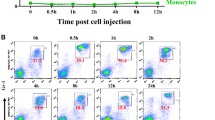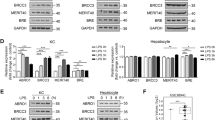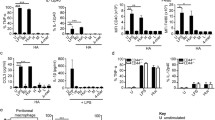Abstract
Kupffer cells, expressing toll-like receptor 4 (TLR4), play a central role in hepatic ischemia/reperfusion (I/R) injury. Hyaluronic acid (HA) fragments, degradative products of high-molecular-weight HA (HMW-HA), acquire the ability to activate immune cells under inflammatory conditions. Here we investigated whether HA fragments could activate Kupffer cells and analyzed the underlying mechanism. Kupffer cells were isolated from wild-type mice (WT, C3H/HeN) and TLR4 mutant mice (C3H/HeJ) and HA fragments were produced by the methods of enzyme digestion and chromatography. Then Kupffer cells were stimulated by HA fragments or other control stimuli. The activation of Kupffer cells was estimated as the release of pro-inflammatory cytokines. The activation of p38 MAPK pathway of Kupffer cells was checked and blocking experiments were done as well. The results indicated that HA fragments acquired the ability to activate Kupffer cells in vitro, which was TLR4 dependent and not due to contamination of lipopolysaccharide. Experiments of p38 MAPK kinase inhibition by SB-203580 verified p38 MAPK was required in HA fragments induced Kupffer cells activation. This suggests that HA fragments, degradative products of one of the major glycosaminoglycans of the extracellular matrix, play critical roles in Kupffer cell activation mediated by TLR4 signaling pathway, which is, at least partially, dependent on p38 MAPK activation.
Similar content being viewed by others
References
Kupiec-Weglinski J W, Busuttil R W. Ischemia and reperfusion injury in liver transplantation. Transplant Proc, 2005, 37: 1653–1656 15919422, 10.1016/j.transproceed.2005.03.134, 1:STN:280:DC%2BD2M3nslWltQ%3D%3D
Fondevila C, Busuttil R W, Kupiec-Weglinski J W. Hepatic ischemia/reperfusion injury—a fresh look. Exp Mol Pathol, 2003, 74: 86–93 12710939, 10.1016/S0014-4800(03)00008-X, 1:CAS:528:DC%2BD3sXjtFWms7g%3D
Tsung A, Hoffman R A, Izuishi K, et al. Hepatic ischemia/reperfusion injury involves functional TLR4 signaling in nonparenchymal cells. J Immunol, 2005, 175: 7661–7668 16301676, 1:CAS:528:DC%2BD2MXht1ent7rI
Zhai Y, Shen X D, O’Connell R, et al. Cutting edge: TLR4 activation mediates liver ischemia/reperfusion inflammatory response via IFN regulatory factor 3-dependent MyD88-independent pathway. J Immunol, 2004, 173: 7115–7119 15585830, 1:CAS:528:DC%2BD2cXhtVCqtbfF
Yu M, Wang H, Ding A, et al. HMGB1 signals through toll-like receptor (TLR) 4 and TLR2. Shock, 2006, 26: 174–179 16878026, 10.1097/01.shk.0000225404.51320.82, 1:CAS:528:DC%2BD28Xot1amtrg%3D
Vabulas R M, Ahmad-Nejad P, Ghose S, et al. HSP70 as endogenous stimulus of the Toll/interleukin-1 receptor signal pathway. J Biol Chem, 2002, 277: 15107–15112 11842086, 10.1074/jbc.M111204200, 1:CAS:528:DC%2BD38XjslSgtLs%3D
Kol A, Lichtman A H, Finberg R W, et al. Cutting edge: heat shock protein (HSP) 60 activates the innate immune response: CD14 is an essential receptor for HSP60 activation of mononuclear cells. J Immunol, 2000, 164: 13–17 10604986, 1:CAS:528:DC%2BD3cXisVKg
Sun D, Chen D, Du B, et al. Heat shock response inhibits NF-kappa B activation and cytokine production in murine Kupffer cells. J Surg Res, 2005, 129: 114–121 16243048, 10.1016/j.jss.2005.05.028, 1:CAS:528:DC%2BD2MXhtFCjsb%2FM
Kim J Y, Park J S, Strassheim D, et al. HMGB1 contributes to the development of acute lung injury after hemorrhage. Am J Physiol Lung Cell Mol Physiol, 2005, 288: L958–965 15640285, 10.1152/ajplung.00359.2004, 1:CAS:528:DC%2BD2MXktlSntLY%3D
Powell J D, Horton M R. Threat matrix: low-molecular-weight hyaluronan (HA) as a danger signal. Immunol Res, 2005, 31: 207–218 15888912, 10.1385/IR:31:3:207, 1:CAS:528:DC%2BD2MXkslymtbo%3D
McKee C M, Penno M B, Cowman M, et al. Hyaluronan (HA) fragments induce chemokine gene expression in alveolar macrophages: The role of HA size and CD44. J Clin Invest, 1996, 98: 2403–2413 8941660, 10.1172/JCI119054, 1:CAS:528:DyaK28XntVOhtr0%3D
Taylor K R, Yamasaki k, Radek K A, et al. Recognition of hyaluronan released in sterile injury involves a unique receptor complex dependent on Toll-like receptor 4, CD44, and MD-2. J Biol Chem, 2007, 282: 18265–18275 17400552, 10.1074/jbc.M606352200, 1:CAS:528:DC%2BD2sXmsVOlu7k%3D
Voelcker V, Gebhardt C, Averbeck M, et al. Hyaluronan fragments induce cytokine and metalloprotease upregulation in human melanoma cells in part by signalling via TLR4. Exp Dermatol, 2008, 17: 100–107 18031543, 10.1111/j.1600-0625.2007.00638.x, 1:CAS:528:DC%2BD1cXjs1Cit7w%3D
Cantor J O, Nadkarni P P. Hyaluronan: the jekyll and hyde molecule. Inflamm Allergy Drug Targets, 2006, 5: 257–260 17168797, 10.2174/187152806779010936, 1:CAS:528:DC%2BD28XhtlSjtb%2FE
Laurent T C, Fraser J R. Hyaluronan. FASEB J, 1992, 6: 2397–2404 1:CAS:528:DyaK38XltVKgu7o%3D
Reinders M E, van Wagensveld B A, van Gulik T M, et al. Hyaluronic acid uptake in the assessment of sinusoidal endothelial cell damage after cold storage and normothermic reperfusion of rat livers. Transpl Int, 1996, 9: 446–453 8875786, 10.1111/j.1432-2277.1996.tb00987.x, 1:CAS:528:DyaK2sXjtFGqsg%3D%3D
Jeyabalan G, Tsung A, Billiar T R. Linking proximal and downstream signalling events in hepatic ischaemia/reperfusion injury. Biochem Soc Trans, 2006, 34: 957–959 17052236, 10.1042/BST0340957, 1:CAS:528:DC%2BD28XhtFWnsb3I
Munthe-Kaas A C, Berg T, Seglen P O, et al. Mass isolation and culture of rat Kupffer cells. J Exp Med, 1975, 141: 1–10 1090696, 10.1084/jem.141.1.1, 1:STN:280:DyaE2M7hsFykug%3D%3D
Termeer C C, Hennies J, Voith U, et al. Oligosaccharides of hyaluronan are potent activators of dendritic cells. J Immunol, 2000, 165: 1863–1870 10925265, 1:CAS:528:DC%2BD3cXls1Kmsrg%3D
Jaeschke H. Molecular mechanisms of hepatic ischemia-reperfusion injury and preconditioning. Am J Physiol Gastrointest Liver Physiol, 2003, 284: G15–26 12488232, 1:CAS:528:DC%2BD3sXntVSgug%3D%3D
Wang H, Li Z Y, Wu H S, et al. Endogenous danger signals trigger hepatic ischemia/reperfusion injury through toll-like receptor 4/nuclear factor-kappa B pathway. Chin Med J (Engl), 2007, 120: 509–514 1:CAS:528:DC%2BD2sXkvVKqtrs%3D
Teoh N C, Farrell G C. Hepatic ischemia reperfusion injury: Pathogenic mechanisms and basis for hepatoprotection. J Gastroenterol Hepatol, 2003, 18: 891–902 12859717, 10.1046/j.1440-1746.2003.03056.x, 1:CAS:528:DC%2BD3sXnvFSlurk%3D
Nanashima A, Yamaguchi H, Tanaka K, et al. Preoperative serum hyaluronic acid level as a good predictor of posthepatectomy complications. Surg Today, 2004, 34: 913–919 15526125, 10.1007/s00595-004-2845-y
Rockey D C, Chung J J, McKee C M, et al. Stimulation of inducible nitric oxide synthase in rat liver by hyaluronan fragments. Hepatology, 1998, 27: 86–92 9425922, 10.1002/hep.510270115, 1:CAS:528:DyaK1cXlvVeqsg%3D%3D
Mummert M E. Immunologic roles of hyaluronan. Immunol Res, 2005, 31: 189–206 15888911, 10.1385/IR:31:3:189, 1:CAS:528:DC%2BD2MXkslymtb0%3D
Soltés L, Mendichi R, Kogan G, et al. Degradative Action of Reactive Oxygen Species on Hyaluronan. Biomacromolecules, 2006, 7: 659–668 16529395, 10.1021/bm050867v
Termeer C, Benedix F, Sleeman J, et al. Oligosaccharides of Hyaluronan Activate Dendritic Cells via Toll-like Receptor 4. J Exp Med, 2002, 195: 99–111 11781369, 10.1084/jem.20001858, 1:CAS:528:DC%2BD38XjslOjtw%3D%3D
Beg A A. Endogenous ligands of Toll-like receptors: implications for regulating inflammatory and immune responses. Trends Immunol, 2002, 23: 509–512 12401394, 10.1016/S1471-4906(02)02317-7, 1:CAS:528:DC%2BD38XotVKksbs%3D
Tsan M F, Gao B. Endogenous ligands of Toll-like receptors. J Leukoc Biol, 2004, 76: 514–519 15178705, 10.1189/jlb.0304127, 1:CAS:528:DC%2BD2cXnsVaksrk%3D
Maung A A, Fujimi S, Miller M L, et al. Enhanced TLR4 reactivity following injury is mediated by increased p38 activation. J Leukoc Biol, 2005, 78: 565–573 15857937, 10.1189/jlb.1204698, 1:CAS:528:DC%2BD2MXntFCjsbs%3D
Takeuchi O, Akira S. Toll-like receptors: their physiological role and signal transduction system. Int Immunopharmacol, 2001, 1: 625–635 11357875, 10.1016/S1567-5769(01)00010-8, 1:CAS:528:DC%2BD3MXit1OhsLw%3D
Wolf D, Schumann J, Koerber K, et al. Low-molecular-weight hyaluronic acid induces nuclear factor-kappa B-dependent resistance against tumor necrosis factor alpha-mediated liver injury in mice. Hepatology, 2001, 34: 535–547 11526540, 10.1053/jhep.2001.27218, 1:CAS:528:DC%2BD3MXmvV2kt7w%3D
Author information
Authors and Affiliations
Corresponding author
Additional information
These anthors contributed equally to this work
Rights and permissions
About this article
Cite this article
Zhang, J., Wang, H., Xiao, Q. et al. Hyaluronic acid fragments evoke Kupffer cells via TLR4 signaling pathway. SCI CHINA SER C 52, 147–154 (2009). https://doi.org/10.1007/s11427-009-0002-y
Received:
Accepted:
Published:
Issue Date:
DOI: https://doi.org/10.1007/s11427-009-0002-y




